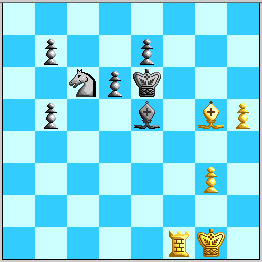
32. g3
Exchanging off the Black thorn in his side (the Black f-pawn) which is preventing his bishop from participating in the action. Kasparov offers his g-pawn in sacrifice in order to promote his h-pawn, creating an unclear endgame with an unusual material balance (should Black accept the sacrifice). Instead 32.Rb1?! vacating the f-file makes no sense, and after 32…b4 33.g3 fxg3 34.fxg3 Bxg3 (34...Kf5 is also fine) 35.h6 Kf5 36.Bd2 Kg6 37.Kg2 Be5 38.Bxb4 Kxh6 39.Bd2+ Kg6 40.Rxb7 e6, which will be a draw. An ironic position, as in the opening Black offered up a rook for a knight and two (central) pawns.
32.g4 transposes to the game continuation after 32...fxg3.
32. … fxg3
Instead 32…f3?! seemed incorrect after 33.Rb1 b4 34.g4, with advantage to White.
33. fxg3

Black's first major decision in this endgame - can Black really take the pawn on g3? My first instinct was to say "No!" but I knew better than to dismiss any candidate move out of hand, and the at-first-glance risky 33…Bxg3 deserves as much consideration as any other likely looking candidate move - here only 33…b4 persisting with Black's queenside counterplay was also under review.
Let's look at the move WT didn't play - the "show me" 33…Bxg3!? The jury is out on this move, as the resulting variations are difficult and not too clear in my opinion. Of the four official MSN analysts I may have been the only one who even looked at this variation, and as a result it is doubtful that the move could ever have won the vote regardless of our final assessment.
After 33...Bxg3!? 34.h6 (the only consistent move) 34...Be5 (34...Nd8 loses to 35.h7 Be5 36.Bf6) 35.h7, and now:
A) 35...Bh8? 36.Rf8 Ne5, loses in a spectacular and intricate manner after 37.Rxh8 Nf3+ 38.Kf2 Nxg5 39.Ke3, with:
A1) 39...b4 40.Kf4 b3 41.Kxg5 b2 42.Rf8! b1=Q 43.h8=Q Qg1+, when White evades the perpetual check with 44.Kf4! Qf2+ 45.Ke4 Qe2+ 46.Kd4 Qd2+ 47.Kc4 Qe2+ 48.Kb4 Qe4+ 49.Kb3 Qd5+ 50.Kc3 Qa5+ 51.Kd3! Qb5+ 52.Ke3 Qb3+ 53.Kf2 Qc2+ 54.Kg3 Qg6+ 55.Kf4, and White wins - so beautiful! If instead:
A2) 39...Kd5 40.Kf4 Nxh7 41.Rxh7 e5+ (or 41...Kd4 42.Rxe7 b4 43.Rxb7 Kc3 44.Ke3 b3 45.Rc7+, and White wins) 42.Ke3, and White wins the rook versus 4 pawns endgame as the Black pawns are not well advanced and the White king is well placed.
However, Black can improve with:
B) 35…Bg7, which is far less clear, for example:
B1) 36.Rf8?! b4 (not 36...Ne5? 37.Bh6! and White wins) 37.h8=Q Bxh8 38.Rxh8 Kd5! (this variation was championed by the Computer Chess Team), and now I looked at the following variations with GM Ron Henley and SmartChess Online analysts. We came to the conclusion that after 38…Kd5, the position was unclear (we did not think our analysis was exhaustive), but that Black may be holding OK:
B11) 39.Kf2 b3! with:
B111) 40.Ke2 b2 41.Rh1 Kc4 42.Rb1 (42.Kd2 loses to 42…Kb3) 42...Kc3 43.Kd1 Ne5 44.Bd2+ (44.Bxe7 Ng4! 45.Bxd6 Ne3+ 46.Ke2 Nc4 47.Bf8 Kc2 48.Rh1 b1=Q 49.Rxb1 Kxb1, with a draw) 44...Kb3 45.Bc1 Nd3! (45...Nc4 loses to 46.Bxb2 Nxb2+ 47.Kc1) 46.Bxb2 Ka2! 47.Kc2 Nb4+ 48.Kc1 Nd3+, with a pretty draw.
B112) 40.Bc1 Ne5! 41.Rh3 (41.Ke2 Nc4! favors Black, while 41.Rh5? loses to 41…Kc4 42.Ke2 Kc3 43.Rh3+ Kc2 44.Bd2 b2 45.Rc3+ Kb1) 41...Kc4 42.Ke2 Kb4 43.Re3 Nc4 44.Rxe7 b6, with equal chances.
B12) 39.Kf1 (preparing to establish a blockade, an idea proposed to me by Henley, appears to be White's most annoying try in this line) 39…b3, and now:
B121) 40.Bc1 Ne5 41.Rh3 (41.Ke2 Nc4! with an edge for Black) 41...Kc4 42.Ke2 Kb4 43.Re3 Nc4 44.Rxe7 b6, equal.
B122) 40.Ke2 transposes to 39.Kf2 b3 40.Ke2 (Variation B111).
B123) 40.Rh2 Kc4 41.Ke1 Ne5, with:
B1231) 42.Rh4+? Kc3 43.Rh3+, and now:
B12311) 43...Nd3+? loses to 44.Kd1 (instead 44.Ke2 b2 45.Rxd3+ Kc4 46.Rd1 Kc3 47.Bxe7 Kc2 48.Rd2+ Kb3 49.Rd1 Kc2 50.Rd2+, with a draw) 44...b2 45.Bd2+ Kb3 46.Rxd3+ Ka2 47.Bc1!! b1=Q 48.Ra3 mate.
B12312) 43...Kc2 44.Rh2+ Kb1 45.Kd1 (45.Rh1 b2 46.Kd2+ Ka2 47.Kc2 Nc4 48.Bxe7 Ne3+ 49.Kd2 b1=Q 50.Rxb1 Kxb1 51.Kxe3, with a draw) 45...b2 46.Bxe7 Ka1 47.Rxb2 Kxb2 48.Bxd6, draw.
B1232) 42.Kd1 Nf3, and now:
B12321) 43.Rg2 b2 44.Rxb2 Nxg5 45.Rxb7, draw.
B12322) 43.Rh5 e5, with the idea of advancing the d- and e-pawns. The position is unclear and it is not fully explored but so far it appears to hold for Black. The Computer Chess Team believes it be a draw.
White need not promote on h8 immediately, and has other dangerous tries.
In fact some weeks after Black's move 33, I thought I had found a dangerous idea for White in the following line:
B2) 36.Bc1! (White's most dangerous continuation) when Black must be careful, for example:
B21) 36...b4 37.Rf8 Kd5 38.Kf2 b3 39.h8=Q Bxh8 40.Rxh8 Ne5 41.Rh5 Kc4 42.Ke2 Kc3 43.Kd1 Nd3 44.Bd2+ Kb2 45.Rh2 Ka3 (45...Ka1 loses to 46.Bc3+ b2 47.Kc2) 46.Bc3 b2 47.Kc2, and White wins.
B22) 36...Ne5 loses to 37.Bb2 Nf3+ 38.Rxf3 Bxb2 39.Rf8 Kd5 40.Kf1 b4 41.Ke2 b3 42.Kd3 Bg7 43.h8=Q Bxh8 44.Rxh8.
B23) 36...Kd5 loses to 37.Rf2 b4 38.Rh2 Bh8 39.Bb2 Ne5 40.Kf1 Kc4 41.Ke2 Kb3 42.Kd1 b5 43.Bxe5 dxe5 44.Kc1 Kc3 45.Rc2+ Kd3 46.Rc8 Bf6 47.h8=Q Bxh8 48.Rxh8 b3 49.Rh3+ Kc4 50.Re3. Instead Black plays:
B24) 36...Nd8! and after 37.Rf2! not:
B241) 37...b4? 38.Bb2, winning for White, or
B242) 37...Nf7 38.Bb2 Ne5 39.Re2 Kd5 40.Bxe5 dxe5 (40...Bxe5 loses to 41.Rxe5+) 41.Rg2! Bf6 42.Rg6 Bh8 43.Rb6 Kc4 44.Rxb7 b4 45.Rb8 Bf6 46.Kf2 b3 47.Ke3 Kc3 48.Rc8+, and White wins, but:
B243) 37...Bd4 38.Kf1 (Another line in which Black appears to again survive by one tempo is 38.Be3! Bg7 39.Rf4 Nf7 40.Bd4 Bxd4+ 41.Rxd4 Kf5 42.Rh4 Nh8, and Black just holds) 38...Nf7! 39.Rf3 Bf6 (39...Bg7?! 40.Ke2 d5 41.Kd1 d4 42.Kc2 Bh8 43.Kb3 Ne5 44.Rg3 Kf7 45.Kb4 Ng6 46.Kxb5 e5 47.Kc4 e4 48.Bb2, is very good for White) 40.Ke2, with a position that had me worried for Black, and now:
B2431) 40...b4 is bad in view of 41.Kd1 b5 42.Kc2 Nh8 (42...Ng5 43.Rxf6+, wins for White) 43.Bb2 Kf7 44.Bxf6 exf6 45.Rg3, winning.
B2432) 40...Nh8! (the solution, as indicated to me sometime later by IM Ken Regan) 41.Kd3 Kf7 42.Bb2 (42.Ke4 Kg7 43.Rh3 e6, and Black draws, or 42.Rg3 Ng6, with equal chances) 42...Kg7 43.Bxf6+ exf6 44.Rh3 Nf7, and Black holds.
So my original after-the-fact concerns over 33…Bxg3 in the 36.Bc1 line had been allayed. I think it remains to be seen if Black is truly OK in the 36.Rf8 line. Kasparov himself has dismissed 33…Bxg3 as "losing" and I look forward to seeing his own views on this continuation. Further analysis of 33...Bxg3 is being compiled here. Nevertheless, it was clear that the majority of strong analysts preferred the consistent 33…b4, which as we shall see is a fine move for Black.
33. … b4!
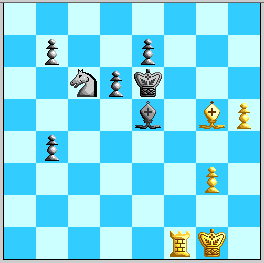
Instead of becoming embroiled in the unbalanced consequences of 33…Bxg3, when a mistaken evaluation would prove likely fatal, all the (available) WT Coaches preferred to continue with Black's queenside counterplay. It turns out this continuation (like any other) is not so simple, although it is probably the principled way to maintain equality, i.e., push the passed pawn!
34. Bf4!?
This continuation had not been studied in any great detail. Most attention had been focussed on the complicated variation beginning with 34.Kf2. Black can navigate the complications and maintain equality after 34…Kf5! For example:
34.Kf2 Kf5! 35.Bd2 (35.Be3 Kg4 36.h6 b3 37.h7 b2 38.Rg1 Bh8, is OK for Black) 35…Ke4 36.g4 (36.h6 b3 37.h7 b2, with the idea Be5-h8 is OK for Black) 36...b3 37.g5 Kd3, and now:
A) 38.h6 (or 38.g6 Kxd2 39.h6 e6) loses to 38…Kxd2 39.g6 e6 40.g7 (or 40.h7 b2, Black wins) 40...Ne7, wins for Black.
B) 38.Be3 e6 (38...b2!?) 39.g6 Ne7 40.Bg5 Nf5 41.Rd1+ (41.h6? b2 42.Kg2 Kc2 43.Rf2+ Kb3 44.Rf1 Ka2 45.Rf2 Ka1, and Black wins) 41...Kc2 42.Rc1+ Kd3 43.Rd1+ Kc2, with a draw. The most critical line is:
C) 38.Bc1! (to give up the bishop for the b-pawn instead of a rook) 38...b2 39.Bxb2 Bxb2, and now there are many ways for White to play, but Black appears to hold his own against this dangerous attempt by White:
C1) 40.g6 Bg7, and now:
C11) 41.Rh1 Bh6 42.Rg1 Bg7 43.Rh1 Bh6, with equal chances.
C12) 41.Rb1 Nd8 42.Rh1 Bh6 43.Rc1 Ne6 44.Re1 Ng7 (44...Nf4!?) 45.Rxe7 Nxh5 46.Rh7 Nf6! 47.Rxb7 Ke4 48.g7 Bxg7 49.Rxg7, draw.
C2) 40.h6 Ne5 41.h7 Ng6, with:
C21) 42.Kf3 Nf8 43.Rb1 Bh8 44.Rd1+ Kc4 45.Rc1+ Kd5 46.Rc8 Nxh7 47.Rxh8 Nxg5+, with advantage to Black.
C22) 42.Kg3 b5 (42...Ke4!?) 43.Kg4 b4 44.Kh5 Nh8 45.Kh6 b3, leads to equal chances.
C3) 40.Kg2 Nd8, and now:
C31) 41.g6 Bg7! 42.Re1 Nc6 43.Rb1 Nd8 44.Rc1 (or 44.Rh1 Ke4 45.h6 Bxh6 46.Rxh6 Ne6 47.Rh4+ Kf5 48.Rb4 Kxg6 49.Rxb7 Kf6, equal) 44...Nc6 45.Rh1 Bh6, with equal chances.
C32) 41.h6 Ne6 42.g6 b5 43.Rf7 b4 44.g7 (not 44.Rxe7 Nf4+ 45.Kf3 Nxg6, and Black wins) 44...Nxg7 45.hxg7 (forced) 45…Bxg7 46.Rxg7 b3 47.Rxe7 b2 48.Rb7 Kc2 49.Kf3 (49.Rc7+ Kd1 50.Rb7, with a draw) 49...b1=Q 50.Rxb1 Kxb1, with a draw.
C33) 41.Rf4 Ne6 42.Rb4 Bc1 43.g6 Ng7 44.Rxb7 Nxh5 45.Rxe7 Nf4+ 46.Kf2 Nxg6 47.Re6, is equal.
C34) 41.Re1!? Nf7 42.g6 Nh6 43.Rxe7 b5 44.Rb7 Kc4! with good counterplay for Black.
C35) 41.Rb1 Bc3, and now:
C351) 42.Rb3 (42.g6 Bg7, or 42.h6 Nf7, favor Black) 42…Nf7! 43.g6 (best) 43...Nh6 44.Rxb7 Bf6 45.Kf3 Kd4, with equal chances.
C352) 42.Kf3 Nf7! 43.g6 Nh6 44.Rxb7 Bf6 45.Rb8 d5, with equal chances.
C4) 40.Re1!? Ne5! and now:
C41) 41.g6 Ng4+! and Black is OK.
C42) 41.Kg3 Nf7 42.Kg4 Nxg5! equal.
C43) 41.Re3+ Kc4 42.Ke2!? Nf7! with a solid blockade defense.
Crucial to the understanding of the lines from 34.Kf2 Kf5, was the work of Otto ter Haar, Ross Amann, IM Ken Regan, and GM Ron Henley.
34. … Bd4+
Avoiding the exchange of bishops, without losing a tempo with 34…Bh8. Moderator GM Danny King appears to like 34…Bh8 35.g4 Nd4!? when he believes Black should hold a draw. This may be right but I was not so sure about this, and in addition I did not like the variation 35…b3?! 36.g5! when the White pawns look dangerous.
After 34…Bd4+, WT analysis had concentrated on the centralizing 35.Kg2. A possible White positional plan would involve active centralization of the White king, followed by maneuvering the king to c2 or b1 (also with the idea Bf4-d2-c3), to neutralize the Black counterplay with his passed b-pawn. This plan seemed worrying as it would completely free the White rook for active duty in the support of the White passed pawns. With some effort we found that after 35…b3 36.Kf3 (Black has excellent counterplay after 36.h6 b2 37.h7 Nb4! or 36.g4 b2 37.h6 Nb4!) 36…b2 37.Ke4 Bh8, Black was probably OK, and I saw analysis by Barnet Chess Club (in England) that continued 38.Kd3 Kd5 39.Kc2 Na5, when Black was doing fine.
Perhaps too comfortable in the knowledge that we had prepared for the worst, our serenity was disturbed when Kasparov showed that he had a surprise waiting for us.
35. Kh1!
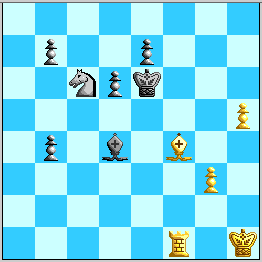
As we shall see, one of the main points of this anti-intuitive king move is to make the g1-square available for the White rook without blocking the g-file with the king. In some variations it is also important that Black cannot play a knight capture on f4 with check (as could be the case with the White king on g2).
This move came as sufficient a shock on Friday evening that I even thought that MSN may have transmitted Kasparov'd move incorrectly. It erased all but one paragraph of the World Team's preparation at a stroke and the rules of the event precluded me from revealing my advance knowledge of 35. Kh1 to anyone on the Bulletin Boards. That one paragraph had come in e-mail to Henley from IM Ken Regan the day before, and Regan in turn had picked up on Florin Felecan's suggestion on 34.Bf4 that after 34...Bd4+ White might play 35.Kh2 to avoid checks and leave the g-file open later for the rook (Regan and Henley were friends on the junior circuit in the 1970s). What was significant about the e-mail was not so much suggesting 35.Kh1 itself but its having a short yet correct demonstration that after 35...b3 36.g4, the natural 36...b2 would lose by force!
The e-mail gave me some material to work with and the basic points on which to start building a 35.Kh1 file with my team of Henley, Koval, and Hodges. We found all the additional immediate tactical ideas of 35. Kh1, and working through the night did enough to determine that the natural 35...b3 was OK for Black - at least until the next crisis!
As far as I can tell I was the only "official" MSN analyst who read the MSN Bulletin Boards and interacted with any of the World Team members on a regular basis. In many ways, I had become the unofficial voice of the contributors to the MSN Bulletin Boards to the voters at large.
It was around this time, that I decided to stop monitoring the MSN Bulletin Boards. I found that a number of posters had become increasingly objectionable and obnoxious. Throughout the game, starting at around move 10, I had to run a gamut of personal insults, including suggestions that I was incapable of analyzing any position for myself, and that my ideas were "stolen" from other people. I had to read about personal attacks on or insinuations about my friends, trainers, family and sponsors. I had grown tired of the situation and felt I did not need to put up with such aggravation any longer. I decided from that point on I would simply honor my duties in the same way as my fellow MSN analysts.
The volunteers who maintained the analysis files (often around the clock) for the World Team on the smartchess.com site had gotten fed up with the criticism leveled at them, and decided to end their volunteer efforts.
After a couple of days, following a touching and heartfelt plea from a number of World Team members (organized by John O'Connell on an independent web-site), together with many supportive e-mails, I reconsidered my decision and solved the situation I found myself in by simply removing certain posters from my reading list, and steering clear of any anonymous posts. I re-established the analysis files on the smartchess.com web-site with the help of staff there.
By move 40, my reading list on the MSN Bulletin Boards had been pruned to about 20 posters whom I considered to be real team players. By the time we reached the queen ending on move 50, due to other constraints on my time (a return to school, and tournament commitments), my reading list had diminished to less than a dozen people together with my private e-mail interactions with important contributors such as IM Ken Regan, and GM Alexander Khalifman. I believe the MSN Bulletin Boards were an important part of the engine that powered the World Team, although the World Team had to endure certain elements who continuously undermined the team spirit during the course of the game (for example: posters of misinformation, doomsayers, and delusional egomaniacs who believed that the World Team could not function without them).
35. … b3
This keeps the game in very complicated channels. Kasparov has indicated in post-game comments that 35…Ne5 (which received scant attention from our team) would lead to a draw after 36.Bxe5 dxe5 (not 36…Bxe5 37.Rf3, and White is close to winning). However, one must be confident in defending against the variation 37.h6 b3 38.h7 e4 39.g4.
Trying to cross to the kingside with the Black king is insufficient. After 35…Kf5? White gets a winning advantage with 36.Be3+ Ke4 37.Bxd4 Kxd4 (37…Nxd4 loses to 38.h6) 38.h6 Ne5 39.h7 Ng6 40.Rf4+ Kc5 (or 40…Kc3 41.Rg4 Nh8 42.Rg8 Nf7 43.Rf8, winning) 41.Rg4 b3 42.Rxg6 b2 43.Rg5+, and White keeps his rook and wins.
The text move is fine and consistent with Black's idea for queenside counterplay, but requires ever-vigilant play from Black.
36. g4
The strongest move, and one that demands an exact response from Black.
36. … Kd5!
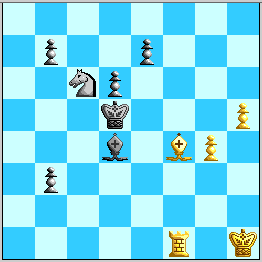
The alternatives are bad for Black:
A) 36...b2 loses after 37.g5, and now:
A1) 37...Na5 38.g6 Nc4 (38...Nb3 loses to 39.h6 Nc1 40.g7) 39.h6 Na3 40.g7, and White wins.
A2) 37...Kd5 38.g6 transposes to 36...Kd5 37.g5 b2 38.g6, leading to a winning position for White (as we shall see shortly).
A3) 37...Ne5 (or 37...Nb4) 38.g6 Nd3 transposes to 36...Nb4 37.g5 b2 38.g6 Nd3, (Variation C1) which is winning for White.
B) 36...Ne5 37.g5 Nd3 transposes to 36...Nb4 37.g5 Nd3 (Variation C2).
C) 36...Nb4 37.g5, and now:
C1) 37...b2 38.g6 Nd3 (38...Nc2 39.h6 Na3 40.g7 Kf7 41.Be5+, and White wins) 39.h6, transposes to Variation C21.
C2) 37...Nd3 (Here we can see a point to Kg1&endash;h1, in that Nd3xf4 will not be check, and if the White king had been on h2 with 35.Kh2 there is no possibility of a Bd4-e5 pin) 38.h6, and now:
C21) 38...b2 39.g6, with:
C211) 39…Nxf4 40.g7 Kf7 41.Rxf4+ Bf6 42.Rf1 Kg8 (or 42...d5 43.Rg1 Bg5 44.g8=Q+ Kxg8 45.Rxg5+, and White wins) 43.Rg1 (another point of 35.Kh1 is revealed) 43...Bg5 44.h7+ Kxh7 45.g8=Q+ Kxg8 46.Rxg5+, White wins.
C212) 39...Nc1 40.g7 b1=Q (40...Bxg7 41.hxg7 Kf7 42.Be5+, wins for White) 41.g8=Q+, winning.
C213) 39...b1=Q 40.Rxb1 Nxf4 41.Re1+! Be5 42.g7 Kf7 43.Rg1, and White wins, and again we see a significance to 35.Kh1.
C214) 39...Bf6 40.g7 Kf7 41.Rg1 Bxg7 42.hxg7 Kg8 43.Bh6 Nc1 44.Rf1 b1=Q 45.Rf8+ Kh7 46.Rh8+ Kg6 47.g8=Q+ wins for White.
C22) 38...Nxf4 39.Rxf4 b2 40.Rf1 b1=Q (relatively best) 41.Rxb1 Kf5 42.Rb5+! Kg6 43.Kg2, analyzed to be winning for White.
37. g5
The only consistent move for White. The passed pawns look very dangerous and Kasparov must have felt he was in the driving seat as he described this game to the press in London. However, the World Team had seen deeply into the position and now produced a fine defensive maneuver which indicated clearly that the game was still in precarious balance.
37. … e6!
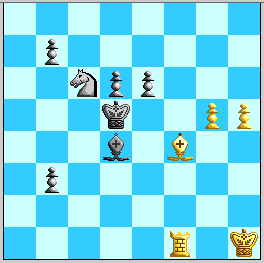
An excellent defensive resource that shows the remarkable resilience of Black's game.
It is thought that this defense was underestimated by Kasparov, who had indicated that the WT had missed an opportunity to hold a draw with 35…Ne5.
In my view, it appears that White has no way of demonstrating any advantage after 37…e6, and I believe the defense discovered by Black in this game, viz., 35…b3 36.g4 Kd5! 37.g6 e6! is optimal play by Black and a testament to the analytical capabilities of the World Team.
It should be pointed out that the World Team survived a very narrow vote to carry the essential 36…Kd5! and 37…e6! beat out a strong challenge from the very weak move 37…e5? In the voting.
Instead, it was very easy for Black to make a fatal error at this point. For example:
If 37...e5? then 38.Bc1! (redirecting the bishop to a3) puts Black under incredible pressure, for example: 38…Ne7 39.Rf7! Ke6 40.Rf6+, and now:
A) 40...Kd5 41.h6! b2 (41...e4 42.h7 Bxf6 43.gxf6 Ng6 44.f7, winning) 42.Bxb2 Bxb2 43.h7, winning for White.
B) 40...Kd7 41.Ba3 b2 42.Rf1, and now:
B1) 42...Be3 43.g6 Bc1 44.Bxb2! Bxb2 45.g7 Ke6 46.Rf8, wins.
B2) 42...Nf5 43.Kh2! 43...Ke6 44.h6 e4 (44...Ne7 45.Rf6+, or 44...Ne3 45.Rb1 Nc4 46.Bxb2! Nxb2 47.g6, win for White) 45.Rb1 Kf7 46.Bxb2 Kg6 47.Kh3, and White wins.
B3) 42...e4 43.Rb1 Nf5 44.h6 Nh4 45.Bxb2 Bxb2 46.Rxb2, and White wins.
If Black tries 37...b2 (to stop the Bf4-c1 maneuver), White is able to effect a remarkable win as shown in this variation developed on the MSN Bulletin Boards:
38.g6 Nd8 39.Be3! Be5 (forced) 40.h6 Ne6 41.Bg5 Ng7 (41...Ke4 42.Bxe7 Kd3 43.Bf8 Kc2 44.g7 Nxg7 45.Bxg7, wins for White) 42.hxg7 Bxg7 43.Bxe7, and now:
A) 43...b5 44.Kg2, with:
A1) 44...b4 45.Kg3 Kc4 (45...b3 loses to 46.Kg4) 46.Bxd6 b3 47.Ba3, and White wins.
A2) 44...Kc4 45.Bxd6 Kb3 46.Kf3 Ka2 47.Ke4 b1=Q+ 48.Rxb1 Kxb1 49.Kf5 Kc2 50.Ke6 Kd3 51.Kf7 Bd4 52.Bf8 Ke4 - see Variation B.
B) 43...Kc4 44.Bxd6 Kb3 45.Kg2 Ka2 46.Kf3 b1=Q 47.Rxb1 Kxb1 48.Ke4 Kc2 49.Kf5 49...Kd3 50.Ke6 Ke4 (50...Kc4 51.Be5 Bh6 52.Kf7 b5 53.Bf4, wins for White) 51.Kf7 Bd4 52.Bf8 b5 (52...Kf5 53.Bg7 Be3 54.Bc3 Bh6 55.Bb4 b5 56.Ba3, and White wins) 53.Bg7 Bxg7 54.Kxg7 b4 55.Kf8 b3 56.g7 b2 57.g8=Q b1=Q 58.Qh7+, and White wins by one tempo! This variation is one of my favorites in the entire game. It not only reveals some of the hidden beauty in this game, but it also illustrates that chess can sometimes be very cruel.
Black's idea with the move 37…e6 is to relocate his knight on c6 to the f5-outpost (via e7 - a square cleared by the move 37…e6). From f5, the Knight can assist in blockading the enemy passed pawns (perhaps from g6 after h5-h6 by White), or in some eventualities offer itself in sacrifice to stop the White passed pawns. On d5, the Black king remains close to the precious passed pawn on b3, and is ready to assist in the creation of threats to promote the Black b-pawn (with maneuvers such as Kd5-c4-b3-a2, or Kd5-c4-b3-c2, or Kd5-c4-d3-c2, for example). Kasparov has indicated he overlooked the resources that this defense with 37…e6 held for Black, and he now switched to what he called his "reserve" line. Presumably, he had wanted to play 38.Rd1, a move that was greatly feared for a while on the MSN Bulletin Boards. Here is a brief review of White's alternatives after 37…e6.
Of White's alternatives, 38.Rd1 came closest to derailing the World Team's plans:
38.Rd1 Ke4! 39.Bxd6 (39.Bc1 b5 transposes to 38.Bc1 b5 39.Rd1 Ke4) 39...Kf5 40.g6 Bg7, and now:
A) 41.Rf1+ Kg5 42.Rf7 Na5 43.Ba3 b2 44.Bxb2 Bxb2 45.g7 Bxg7 46.Rxg7+ Kxh5, with a draw.
B) 41.Rg1 b5! with:
B1) 42.h6!? Bxh6 43.g7 Bxg7 44.Rxg7 Ke4 45.Rg3 Na5 46.Ba3 Nc4 47.Rxb3 Nxa3 48.Rxa3 Kd4 49.Kg2 b4 50.Ra4 Kc3 51.Kf3 b3 52.Ra8 b2 53.Rc8+, is a draw.
B2) 42.Rf1+ Kg5 43.Bf8 Bxf8 44.Rxf8 b2 45.Rf1 Kxh5 46.g7 Ne7, Draw.
B3) 42.Bf8 Bxf8 43.g7 Bxg7 44.Rxg7 b2 45.Rg1 Nd4 46.h6 b1=Q 47.Rxb1 Kg6, Draw.
B4) 42.Rb1 b2 43.Ba3 Kg5 44.Bxb2 e5 45.Rg1+ Kxh5 46.Bc1 Ne7 47.Rg5+ Kh4 48.Rg2 (48.Kg1 Bh6 49.Rxe5 Nxg6 50.Re4+ Kh5, Draw) 48...Kh5 49.Bd2 Nxg6 50.Rg5+ Kh6 51.Rxe5+ Kh7 52.Rxb5, Draw.
B5) 42.Bc5 b2 43.Be3 Ke4 44.h6 Kxe3 45.hxg7 Ne7 46.Rb1 Kf4 47.Rxb2 Kf5 48.Rxb5+ Kxg6 49.Rb7 Ng8, with a draw as Black intends Kg6-h7, and Ng8-f6-h5.
B6) 42.Ba3 b4 43.Bc1 b2, and now:
B61) 44.Be3 Ke4 45.h6 Kxe3 46.hxg7 Ne7 47.Rb1 Kd3 48.Rxb2 Kc3 49.Ra2 b3 50.Ra8 b2 51.Rb8 Kc2 52.g8=Q Nxg8 53.Rc8+, with a draw.
B62) 44.Bxb2 Bxb2 45.h6 Bg7! 46.hxg7 Ne7, and Black holds a remarkable draw.
B63) 44.Bd2 Ne7! (Extensive analysis showed that this was the only move), and now:
B631) 45.Bxb4 Ng8!! 46.Ba3 Nf6 47.Bxb2 Nxh5 48.Bxg7 Nxg7 49.Rg2 Kf6 50.Kg1 Nf5 51.Kf2 Kg7 52.Rg4 Ne7, intending Ne7xg6 with a draw.
B632) 45.Rf1+ Ke4, and now after
B6321) 46.h6 Kd3 47.Bxb4 Nf5! or;
B6322) 46.Bxb4!? Nf5 (also 46…Nd5!? seems to hold) 47.Kh2 Ne3! and Black holds the draw. Here is a sample variation: 48.Rg1 Kf5 (Black returns to the White pawns) 49.Kh3 Nd5 50.Bd2 Nf4+ 51.Bxf4 (51.Kh4 loses to Bf6+) 51...Kxf4 52.Kg2 Kg5 53.Rh1 b1=Q 54.Rxb1 Kxh5 55.Rb6 Kxg6, with a draw. I breathed a sigh of relief when SmartChess Online analyst NM David Koval found and analyzed this final piece of the 38.Rd1 puzzle. [There is much more going on here, and eventually I will have it all in this file. ---KWR]
Instead 38.Bc1 was not effective against 37…e6 as it was against the weak 37…e5.
After 38.Bc1, Black plays 38...b5! Saving the back b-pawn is very important. This passed pawn is outside the square of the White King. Now:
A) 39.g6 Ne7 40.Rf7 Nf5! 41.h6 Nxh6 42.Bxh6 b2 43.Rf1 Kc4 44.Rb1 (44.g7 Bxg7 45.Bxg7 e5, illustrates the foundation of Black's drawing plan) 44...Kc3 45.Bc1 bxc1=Q+ 46.Rxc1+ Kb3 47.Rc7 b4 48.g7 Bxg7 49.Rxg7 Kc2, with a draw - this variation illustrates the importance of saving Black's back b-pawn - it is the pawn that is significant (for Black) in the R v Ps endgames that sometimes appear in these variations.
B) 39.Rd1 Ke4! 40.h6 Ne7 41.h7 Ng6 42.Kg2 d5, and Black is OK.
C) 39.h6 Ne7 40.Ba3! Ng6! 41.Kg2 (with the idea Kg2-h3-g4-h5), and now it appears that Black is doing just fine after 41...Be5, for example:
42.Kf3 Kc4 43.Kg4 b4 44.Bc1 b2 45.Bxb2 Bxb2 46.Kh5 Nh8! 47.g6 Nxg6 48.Kxg6 b3, with a draw.
Finally after 38.g6 Ne7, White's most dangerous idea is 39.Rd1.
Black plays 39...Kc4, and now:
A) 40.Bxd6 Nf5 41.Ba3 Ng3+ 42.Kg2 Nxh5 43.Kf3 e5 44.Ke4 b2 (44...b5!?) 45.Rxd4+ exd4 46.Bxb2 d3, leads to a draw.
B) 40.Rc1+ Kd3 41.Rd1+ Kc4, when it was demonstrated that White is well advised to accept the repetition after 42.Rc1+ Kd3 43.Rd1+, etc.
Instead, Kasparov played…
38. h6!?
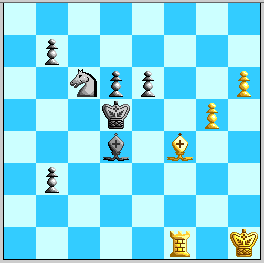
Objectively, this does not give White any advantage. Optically, it looks like White is just winning with an Exchange up and about to make two Queens, but in reality it will come down to a Queen-and-Pawn endgame that Black can equalize in reasonable comfort after less than a dozen sensible moves. However, there is a gulf between between "can" and "will" here. Moreover, with this move, Kasparov offers Black a number of ways to go wrong over a sequence of mutually forcing moves.
38. … Ne7
Bringing the knight to the g6 blockading square.
39. Rd1
Instead 39.Bc1 b5 40.Ba3 Ng6, transposes to a variation discussed after 38.Rd1.
39. … e5
Practically forced. Note that 39…Nf5? is refuted by the pretty 40.h7 b2 41.Be5! b1=Q 42.Rxb1 Bxe5 43.Rb5+ Kd4 44.Rxe5, removing the defender of h8 and therefore winning for White.
Also bad is 39…b2? 40.Be3 (40.Bxd6 is also good) 40…b1=Q 41.Rxb1 Bxe3 42.Rxb7 Ng6 43.Rg7 Nf8 (43…Nh8 loses to 44.Rg8 Nf7 45.h7 Bd4 46.g6 Ng5 47.Kg2) 44.Rg8 Nh7 45.g6 Nf6 46.h7, ad White wins.
40. Be3

Exchanging the bishops and making it clear that White is heading for the queen endgame that now unfolds over the next ten moves.
White's most important alternative was 40.Bc1, but this had been well prepared for with Khalifman's 40…Ke6 (I referred to this as the "Russian Wall" defense). Here are the main ideas of this elaborate but technically sound defense:
40.Bc1 Ke6 (The Black King assists in the elimination of White's pawns) 41.Ba3 Kf5, with:
A) 42.Rb1 Kxg5 43.h7 Ng6, with:
A1) 44.Bc1+ Kf6 45.Rxb3 Kg7 46.Rxb7+ Kh8 47.Rd7 (47.Bg5 e4 48.Kg2 Bg7 49.Be3 Nf8, is equal) 47...Nf4 48.Kh2 (48.Ba3 e4 49.Bxd6 Nh5 50.Bf8 Bg7, with a draw) 48...Nd3 49.Bh6 (49.Bg5 e4 50.Kh3 Bg7 51.Kh4 Ne5 52.Ra7 Nf3+ 53.Kh5 Nxg5 54.Kxg5 Kxh7, with a draw) 49...e4, and Black holds.
A2) 44.Rxb3 Kh6 45.Rxb7 e4 46.Bxd6 e3! (idea 47...e2), and Black draws, for example:
A21) 47.Kg2 Bg7 48.Ba3 (48.Bb4 Kxh7 49.Bc3 Nh4+ 50.Kg3 Nf5+ 51.Kf4 Kg6 52.Rb6+ Kf7! with a draw) 48...Kxh7 49.Bb2 Nh4+ 50.Kg3 Nf5+ 51.Kf4 e2! 52.Bxg7 Nxg7, draw.
A22) 47.Bg3 Bg7 48.Be1 e2, draw.
A23) 47.Bb4 Nh8 48.Kg2 Kg6 49.Kf3 Nf7 50.Bc5!? Ng5+ 51.Kg4 Bf6! 52.Bxe3 Nxh7, draw.
A24) 47.Kh2 .Bg7 48.Bb4 e2 49.Kg3 Kxh7 50.Bc3 e1=Q+ 51.Bxe1 Ne5 52.Bc3 Kg6, draw.
B) 42.h7 Ng6 43.Rb1 Kxg5 44.Rxb3 Kh6 - see Variation A2.
C) 42.Bxd6 Ng6, and now:
C1) 43.Rb1 b2 44.Ba3 Kxg5 45.h7 Kh6 46.Bxb2 Bxb2 (46...Kxh7 47.Bxd4 exd4 48.Rxb7+, with a draw) 47.Rxb2 Kxh7 48.Rxb7+, with a draw.
C2) 43.h7 Kxg5 44.Bf8! b2 45.Bg7 b5! and now, after
C21) 46.h8=Q Nxh8 47.Bxh8 Kg6 48.Rf1 b4! Black holds an incredible draw as his rook on f1 and bishop on h8 cannot function.
C22) 46.Rf1 b4 47.Bf6+ Kh6 48.h8=Q+ Nxh8 49.Bxh8 Kg6, transposes to Variation C21.
40. … Kc4
Now the two kings engage in a race to guide home their respective passed pawns.
41. Bxd4 exd4
42. Kg2 b2
43. Kf3 Kc3
44. h7
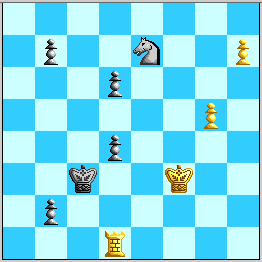
This game seemed to have a little of everything! Here is a complicated endgame with six passed pawns with adventurous kings racing to support the advance of their respective pawns!
Kasparov could have chosen the move order 44.Rb1, but as we shall see with 44.h7, he offers Black some endgame rope to hang himself with - but once again, a WT member came to the fore and steered us on the right path.
After 44.Rb1 d3! 45.h7 Ng6 46.Ke4 Kc2 47.Rxb2+ Kxb2 48.Kf5 (if 48.Kxd3 d5 49.Kd4 b5 50.Kxd5 b4 51.Ke6 b3 52.Kf6 Ka3 53.Kxg6 b2 54.h8=Q b1=Q+, is a theoretical draw) 48…d2 49.Kxg6 d1=Q 50.h8=Q+ Kb1, we arrive at our game position on move 50.
44. … Ng6
45. Ke4 Kc2
46. Rh1 d3
It was sometime during this sequence of essentially forced moves that I received a communication from the organizers indicating they were investigating the possible deployment of a method by which the game could be speeded up, as the game was lasting longer than they had originally expected. The organizers were concerned about the length of the game impinging on the time and schedule of those involved in the project. The method of speeding up the game that they were investigating involved proposing streams of moves ("if" moves) that could be exchanged from side to side with voter approval.
I believed that any changes to the mechanism of how the game was conducted while the game was in progress was inappropriate and could have jeopardized the integrity of the event. In my view, the proposed method that was described to me for speeding up the game would have been disadvantageous to the World Team from all perspectives. It took time, effort and energy for the World Team to coordinate its efforts, formulate conclusions and reach agreement. Allowing streams of moves ("if" moves as they are known in correspondence chess) is counterproductive and counterintuitive to the World Team's playing methodology and would, in my opinion, have served only to contribute to the destruction of the "greatest game of chess ever played". I informed the organizers that I believed that the potential negative backlash and publicity from any perceived alteration or manipulation of the normal course of the game would be permanent and insurmountable. I decided that if such changes were enacted during the course of the game, I would tender my withdrawal from the event.
47. Kf5 b1=Q
The aforementioned rope with which Black could hang himself with was 47…Nh8? where Black steers towards an ending in which White remains with an h-pawn.
After 48.g6 d2 49.g7 d1=Q 50.Rxd1 Kxd1 51.gxh8=Q b1=Q+, we reach an endgame where Black must engineer a method to achieve perpetual check if he is to survive. Certainly, it was worth investigating this "h-pawn ending" for although the White h-pawn has already reached the seventh rank, it is known that h- (or a-) pawns are the least dangerous for the defending side in queen endings.
However, White is able to use the poor position of Black's king with a precise sequence of moves. After 52.Ke6 Qe4+ 53.Kd7! Qa4+ (if 53...Qc6+ 54.Kd8 Qb6+ 55.Kc8 Qc6+ 56.Kb8, and White wins as the White king evades any further checks) 54.Kc7 d5 (A quiet move made possible by the fact that the a1- and d4- squares are defended by Black's queen), 55.Qg7! (Instead after 55.Qc3 Qf4+ 56.Kxb7 Qf7+ 57.Qc7 Qe8! and Black holds a draw), with:
A) 55...Qc4+ 56.Kb8 Qf4+ 57.Kc8 Qc4+ 58.Qc7 Qd4 (or 58...Qg4+ 59.Qd7 Qd4 60.Qf5 Kd2 61.Qg5+ Kd3 62.Qg6+, winning) 59.Qd7 Kd2 (59...Qh8+ fails after 60.Kxb7) 60.Qf5 Qh8+ 61.Kd7 Qg7+ 62.Ke6 Qh6+ 63.Kf7, winning.
B) 55...Qf4+ 56.Kd8 Qh4+ (or 56...Qd6+ 57.Qd7! Qb8+ 58.Ke7 Qe5+ 59.Kf7! Qh5+ 60.Ke6 Qg4+ 61.Kd6 Qd4 62.Qf5! and White wins; 56...Qb8+ loses to 57.Kd7) 57.Qe7! Qf4 58.Ke8 Qb8+ (White wins after 58...Qa4+ 59.Qd7 Qe4+ 60.Kf8 Qf4+ 61.Kg8 Qg5+, and as we have seen before: 62.Kf7 Qh5+ 63.Ke6 Qg4+ 64.Kd6 Qd4 65.Qf5!) 59.Kf7! Qf4+ 60.Ke6 Qe4+ 61.Kd7 Qa4+ 62.Kc7 Qc2+ 63.Kb8! Qh2+ 64.Kxb7 Qb2+ (64...d4 65.Qe4 Kc1 66.Qg6, and White wins) 65.Kc6 Qc2+ 66.Kxd5, winning.
C) 55…Qc6+ 56.Kd8 Qb6+ (or 56...Qd6+ 57.Qd7! Qb8+ 58.Ke7 Qe5+ 59.Kf7! Qh5+ 60.Ke6 Qg4+ 61.Kd6 Qd4 62.Qf5! and White wins) 57.Kc8! Qc6+ (57...Qc5+ 58.Qc7 Qf8+ 59.Qd8 Qf5+ 60.Qd7 Qf8+ 61.Kxb7, and White wins) 58.Qc7! Qf6 59.Qd7! Qh8+ (or 59...Qc3+ 60.Kxb7 Qd4 61.Kc6 Qc4+ 62.Kd6 Qd4 63.Qf5 Qb6+ 64.Kxd5, winning) 60.Kxb7 Qb2+ (60...d4 loses to 61.Qg4+ Kc2 62.Qg8) 61.Kc6 Qh8 (or 61...Qc3+ 62.Kxd5, winning) 62.Qxd5+, and White wins. The critical discoveries in this variation were made by Peter Karrer.
48. Rxb1 Kxb1
49. Kxg6 d2
50. h8=Q d1=Q
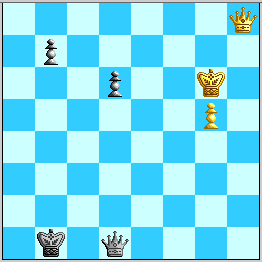
Reaching a queen ending that is drawn, but in which Black must play accurately to demonstrate the balance.
The analysis of this queen ending broke new ground in the theory of queen endgames.
This article continues in a greatly expanded format here.